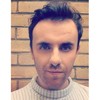Po, who appeared at several meet and greets during DragCon, is escorted across the event floor by a handler. The Teletubbies was one of the event's main sponsors
Drag queens Pangina Heals and Ella Vaday pose with fans during meet-and-greets
Event attendees on a coffee break outside the conference hall
Left: Drag Race-related tattoos on the back of superfan James Robinson, who traveled from the US for the event. Right: Drag queen Tabitha, who appeared on Drag Race Holland
A woman takes a photo in front of merchandise at a vendor booth
A drag queen prepares a wig in one of the events’ vendor booths
Fans watch as a drag queen walks the events’ pink carpet
RuPaul, host of the show RuPaul's Drag Race, which birthed the RuPaul's DragCon UK event, DJs atop a screen displaying an image of RuPaul

